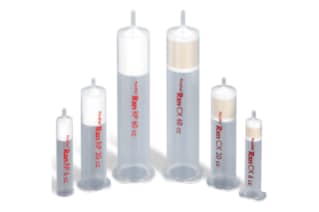PoraPak Rxn
Fast, simple, and cost effective synthesis cleanup
Waters offers PoraPak Rxn, a family of polymer-based chromatography products for superior cleanup of synthetic reactions. PoraPak Rxn products are available in two chemistries: PoraPak Rxn CX, a strong cation-exchange sorbent and PoraPak Rxn RP, a reversed-phase sorbent.
PoraPak Rxn sorbents are based on copolymers that exhibit the following properties:
- Hard material that does not develop increasing back pressure with flow
- Little swelling or shrinking across a range of solvents and pH extremes
- Low hydraulic resistance enables flow by gravity
- pH extreme tolerance without dissolution or hydrolysis, both limitations of silica-based sorbents
